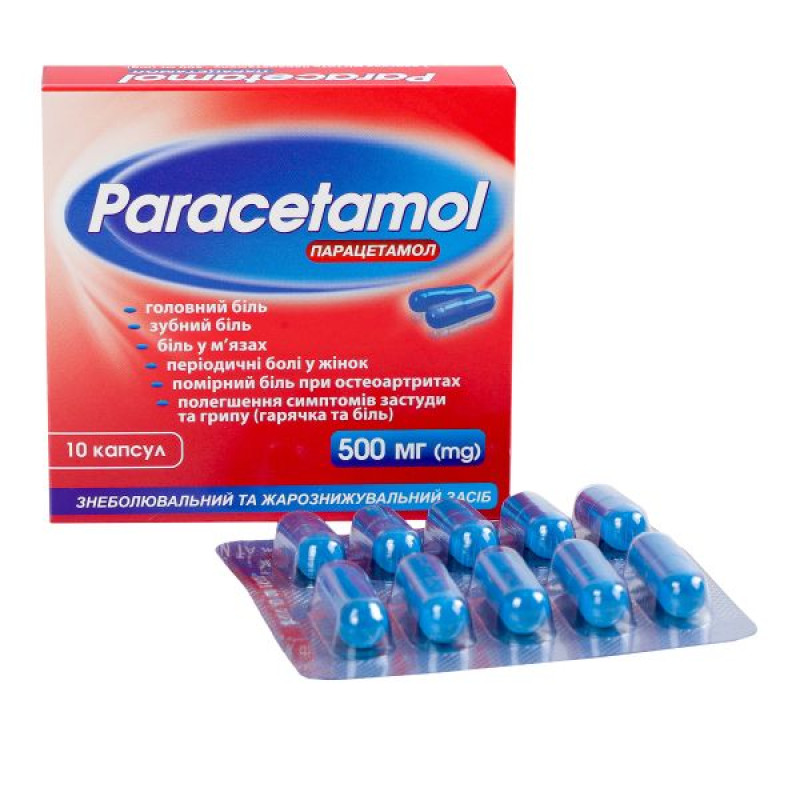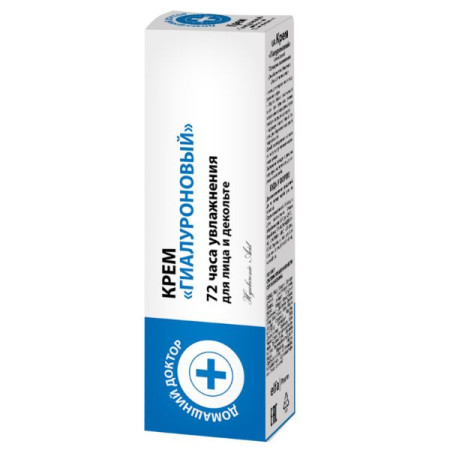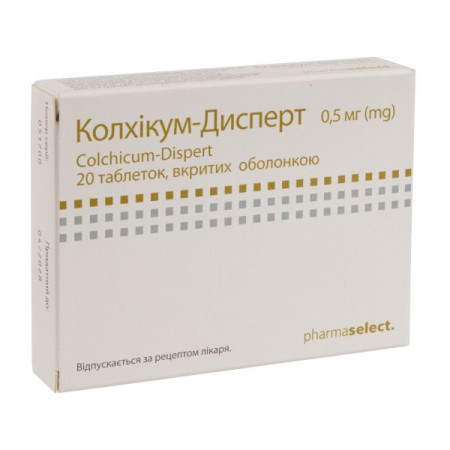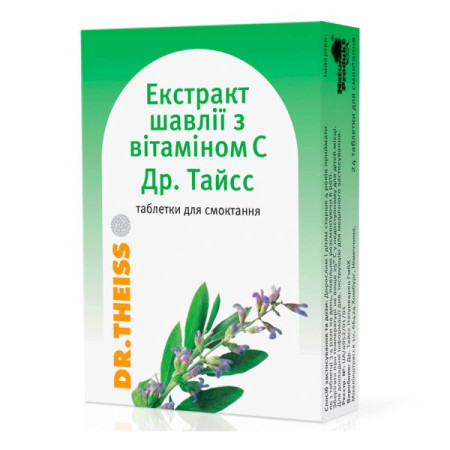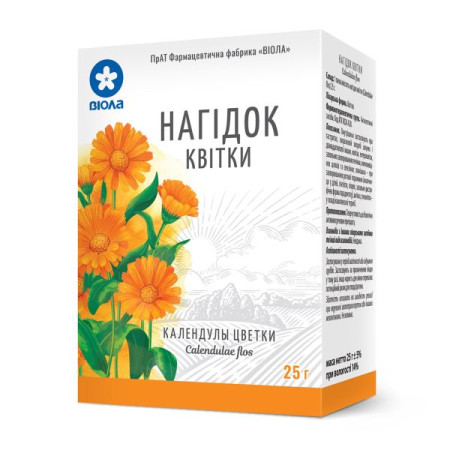Paracetamol capsules 500 mg blister No. 10
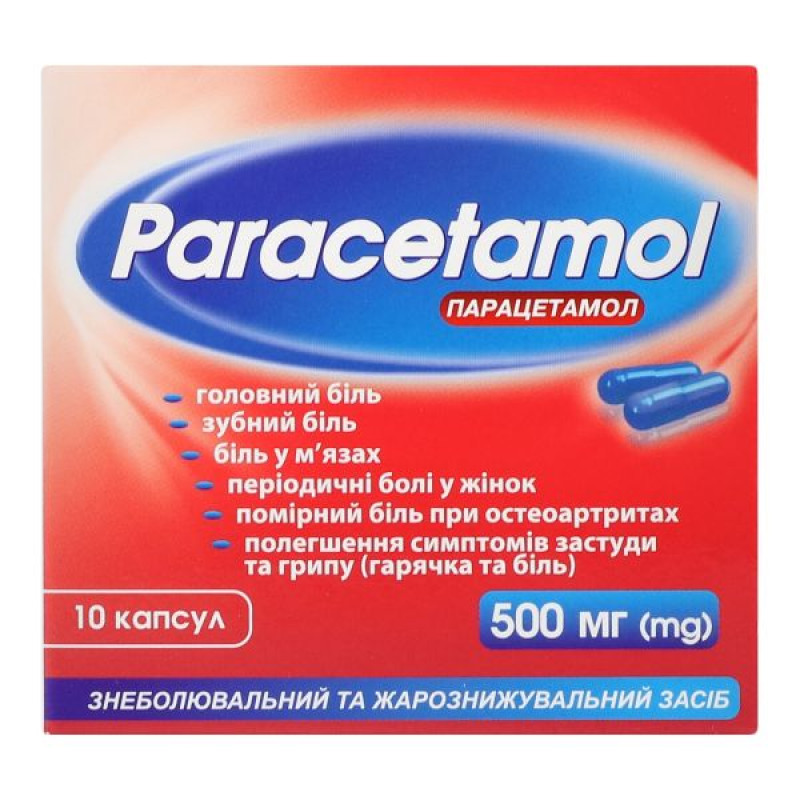
Composition
Active ingredient: each capsule contains 500 mg of paracetamol.
Excipients: potato starch, povidone, magnesium stearate.
Shell: titanium dioxide (E 171), indigo carmine (E 132), gelatin.
Dosage form
Capsules.
Main physicochemical properties:
Capsules are yellow to light blue in color, containing a mixture of granules and white to off-white powder. In some cases, agglomerates of particles may be present.
Pharmacological properties
Paracetamol contains paracetamol, which is an analgesic and antipyretic, meaning it relieves pain and reduces body temperature.
Indication
It is used to relieve headaches, including migraine and tension headaches, toothache, backache, rheumatic pain, muscle pain, and to reduce symptoms of fever and pain associated with colds and flu.
Contraindication
Not recommended for hypersensitivity to any components of the drug Paracetamol, severe liver and/or kidney dysfunction, hyperbilirubinemia from birth, glucose-6-phosphate dehydrogenase deficiency, alcoholism, blood diseases, Gilbert's syndrome, severe anemia, leukopenia.
Interaction with other drugs
The rate of absorption of paracetamol may be increased by concomitant use of metoclopramide and domperidone and decreased by cholestyramine. Warfarin and other anticoagulants may increase their anticoagulant effect with prolonged use of paracetamol, which may contribute to bleeding. Intermittent use has little effect.
Simultaneous use with alcohol is not recommended.
Application features
If you have liver or kidney disease, you should consult a doctor before starting to take the drug.
Patients with non-cirrhotic liver damage caused by alcohol may be at increased risk of hepatotoxic effects from paracetamol. In addition, the drug may affect the results of laboratory tests for blood glucose and uric acid levels.
Patients who must take analgesics daily due to mild arthritis are also advised to consult a doctor.
In infections such as sepsis, which are accompanied by a decrease in glutathione levels in the body, the risk of metabolic acidosis increases when using paracetamol. Symptoms of this condition may include deep, rapid or difficult breathing, nausea, vomiting and loss of appetite. If these symptoms occur, you should consult a doctor immediately.
Do not exceed the recommended dose of the drug.
If the headache becomes persistent, it is also recommended to consult a doctor.
Keep the medicine out of the reach and sight of children.
Drivers
Paracetamol does not affect the reaction speed when driving or using other mechanisms.
Pregnant and lactating women
In case of pregnancy or breastfeeding, the drug can be prescribed only if the expected benefit to the mother outweighs the potential risk to the fetus or child.
Method of administration and doses
Paracetamol is intended for oral administration.
Adults and children over 12 years of age are recommended to take 1-2 capsules 4 times a day.
Children aged 6 to 12 years are recommended to take 1 capsule 3-4 times a day.
The minimum interval between doses is 4 hours.
Do not exceed the maximum daily dose of 8 capsules (4000 mg) within 24 hours.
The duration of treatment should be determined by a doctor.
The maximum period of use of the drug without consulting a doctor is 3 days.
Do not use the drug simultaneously with other products containing paracetamol.
Children
Not recommended for children under 6 years of age.
Overdose
Overdosing on Paracetamol tablets can be dangerous. Adults who take 10 g or more of paracetamol, and children who take more than 150 mg of paracetamol per kilogram of body weight, are at risk of liver damage.
Symptoms of Paracetamol overdose in the first 24 hours may include pallor, nausea, vomiting, loss of appetite and abdominal pain. Liver damage may occur 12-48 hours after overdose. Glucose metabolism disorders and metabolic acidosis may occur. In severe cases, liver failure may develop, which can lead to encephalopathy, hemorrhage, hypoglycemia, coma and death.
With prolonged use of the drug in high doses, hematopoietic disorders such as aplastic anemia, pancytopenia, agranulocytosis, neutropenia, leukopenia, and thrombocytopenia may occur.
If an overdose is suspected, seek medical attention immediately.
Adverse reactions
If you experience any side effects, stop using the medicine and consult a doctor. Side effects of paracetamol are extremely rare and occur in less than one patient in 10,000:
- Digestive system: epigastric pain, nausea.
- Endocrine system: hypoglycemia, up to hypoglycemic coma.
- Blood and lymphatic system: anemia, thrombocytopenia, sulfhemoglobinemia and methemoglobinemia, agranulocytosis.
- Respiratory system: bronchospasm in patients who are hypersensitive to aspirin and other nonsteroidal anti-inflammatory drugs.
- Hepatobiliary system: increased activity of liver enzymes, usually without jaundice, impaired liver function.
Expiration date
Storage conditions
Store Paracetamol in its original packaging at a temperature not exceeding 25 ºC.
Keep it out of the reach of children.
You can buy Paracetamol capsules 500 mg in pharmacies of our network or order on the website.
There are no reviews for this product.
There are no reviews for this product, be the first to leave your review.
No questions about this product, be the first and ask your question.






